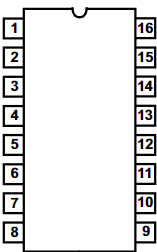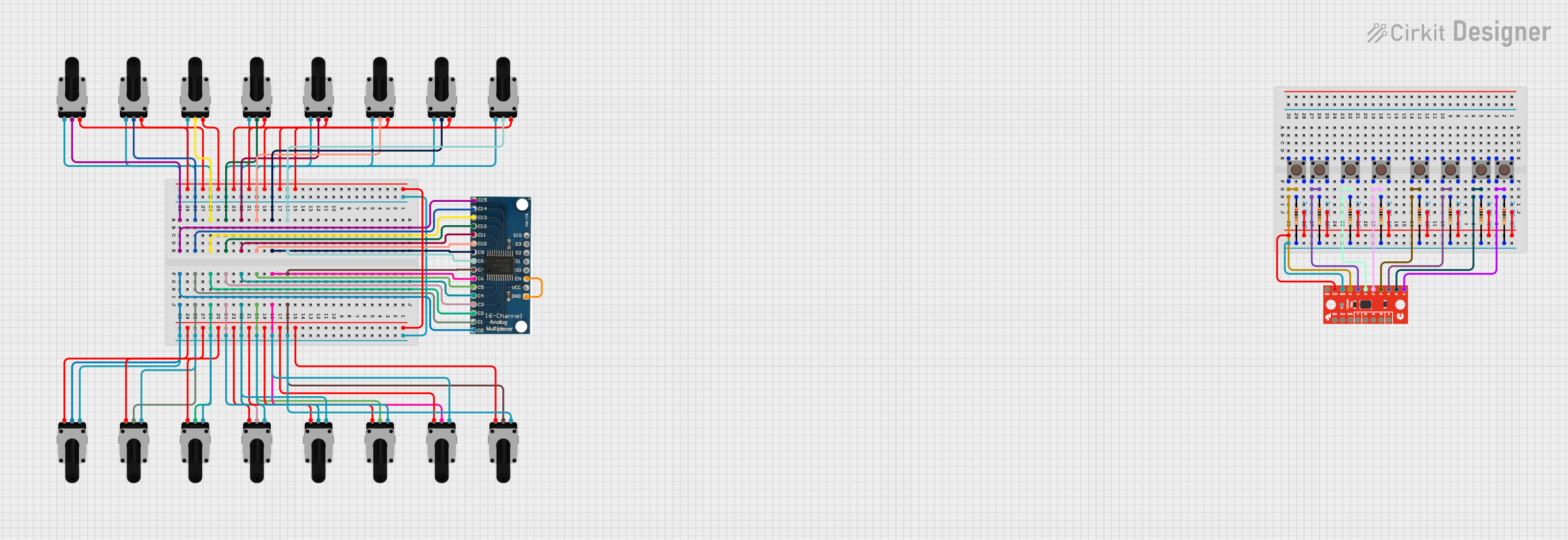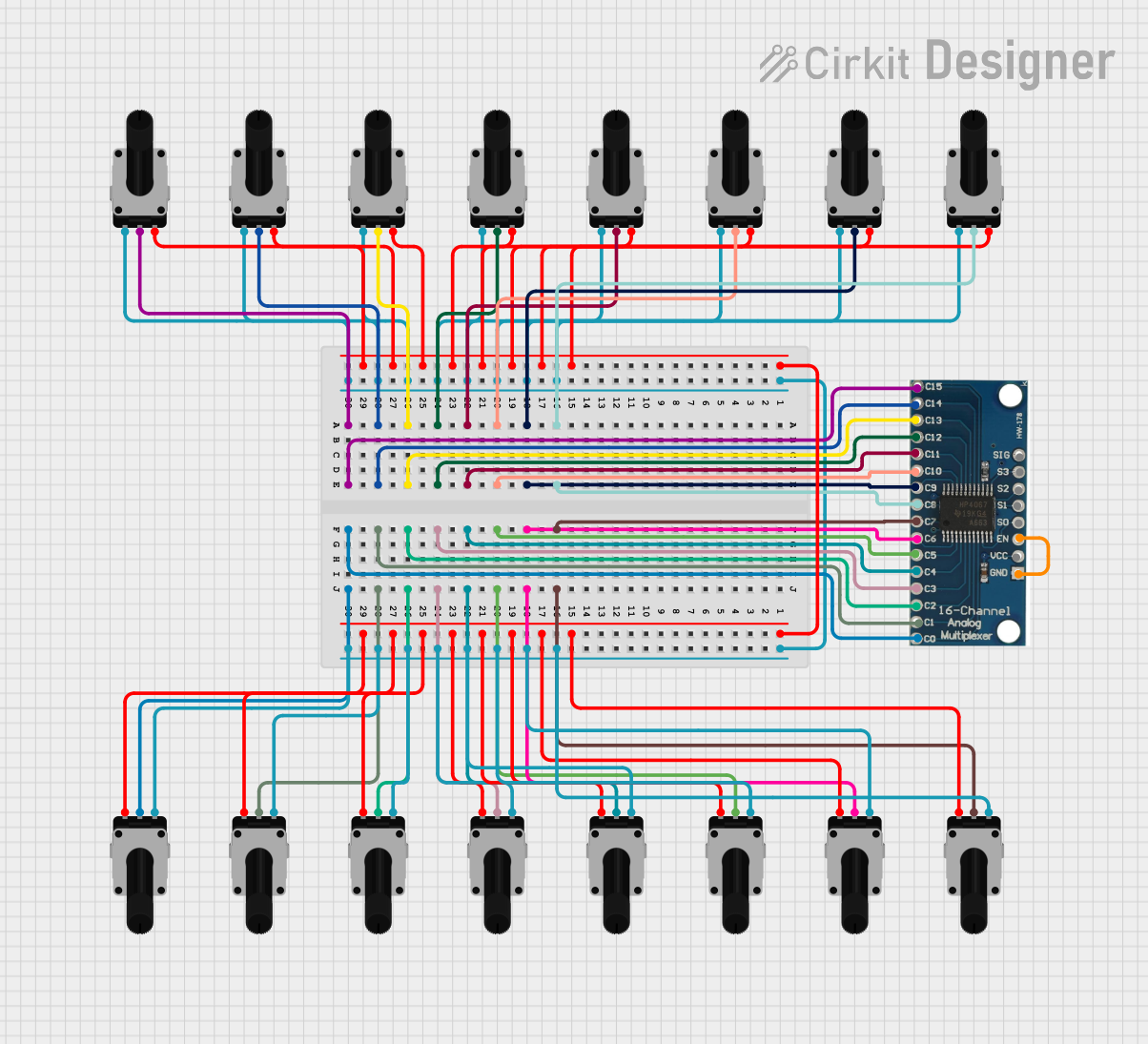
How to Use 8:1 Analog Multiplexer: Examples, Pinouts, and Specs

 Design with 8:1 Analog Multiplexer in Cirkit Designer
Design with 8:1 Analog Multiplexer in Cirkit DesignerDocumentation for CD4051 8:1 Analog Multiplexer
Manufacturer: Texas Instruments
Part ID: CD4051
1. Introduction
The CD4051 is an 8:1 analog multiplexer/demultiplexer manufactured by Texas Instruments. It is a versatile integrated circuit (IC) that allows the selection of one of eight analog input signals and forwards the selected input to a single output line. The selection is controlled by three digital select lines. This IC is widely used in applications requiring signal routing, data acquisition, and analog signal processing.
Common Applications
- Signal multiplexing in data acquisition systems
- Audio signal routing
- Sensor signal selection
- Analog-to-digital conversion (ADC) channel selection
- Test equipment and instrumentation
2. Technical Specifications
The following table outlines the key technical specifications of the CD4051:
| Parameter | Value |
|---|---|
| Supply Voltage (V_DD) | 3V to 18V |
| Input Voltage Range | 0V to V_DD |
| On-Resistance (R_ON) | 125Ω (typical at V_DD = 10V) |
| Maximum Input Current | ±10mA |
| Power Dissipation | 700mW (maximum) |
| Operating Temperature Range | -55°C to +125°C |
| Control Logic Voltage Levels | Compatible with CMOS and TTL |
Pin Configuration and Descriptions
The CD4051 is available in a 16-pin DIP, SOIC, or TSSOP package. The pinout is as follows:
| Pin Number | Pin Name | Description |
|---|---|---|
| 1 | X0 | Analog Input 0 |
| 2 | X1 | Analog Input 1 |
| 3 | X2 | Analog Input 2 |
| 4 | X3 | Analog Input 3 |
| 5 | X4 | Analog Input 4 |
| 6 | X5 | Analog Input 5 |
| 7 | X6 | Analog Input 6 |
| 8 | V_EE | Negative Supply Voltage (typically 0V for single-supply operation) |
| 9 | X7 | Analog Input 7 |
| 10 | COM | Common Output (or Input in demultiplexer mode) |
| 11 | INH | Inhibit Control (active HIGH, disables all channels when HIGH) |
| 12 | A | Select Line A (LSB) |
| 13 | B | Select Line B |
| 14 | C | Select Line C (MSB) |
| 15 | V_DD | Positive Supply Voltage |
| 16 | V_SS | Ground (0V reference) |
3. Usage Instructions
Connecting the CD4051 in a Circuit
Power Supply:
- Connect the V_DD pin to the positive supply voltage (e.g., 5V or 12V).
- Connect the V_SS pin to ground (0V).
- For single-supply operation, connect V_EE to ground. For dual-supply operation, connect V_EE to a negative voltage (e.g., -5V).
Input and Output Connections:
- Connect up to eight analog signals to the X0 to X7 pins.
- The selected signal will appear on the COM pin.
Control Logic:
Use the A, B, and C pins to select the desired input channel. These pins accept digital logic levels (0 or 1).
The binary combination of A, B, and C determines the active input channel:
C B A Selected Input 0 0 0 X0 0 0 1 X1 0 1 0 X2 0 1 1 X3 1 0 0 X4 1 0 1 X5 1 1 0 X6 1 1 1 X7
Inhibit Control:
- When the INH pin is HIGH, all channels are disabled, and the COM pin is disconnected.
Best Practices
- Use decoupling capacitors (e.g., 0.1µF) between V_DD and V_SS to reduce noise.
- Avoid exceeding the maximum voltage ratings to prevent damage to the IC.
- For high-impedance signals, consider buffering the output to minimize loading effects.
4. Example: Using CD4051 with Arduino UNO
The following example demonstrates how to use the CD4051 to read multiple analog signals with an Arduino UNO.
Circuit Diagram
- Connect the X0 to X7 pins to eight analog signal sources (e.g., potentiometers).
- Connect the COM pin to the Arduino's A0 pin.
- Connect the A, B, and C pins to Arduino digital pins 2, 3, and 4, respectively.
- Connect V_DD to 5V, V_SS to GND, and V_EE to GND.
Arduino Code
// Define control pins for the CD4051
const int selectPinA = 2; // Select line A
const int selectPinB = 3; // Select line B
const int selectPinC = 4; // Select line C
const int analogInput = A0; // Common output connected to Arduino A0
void setup() {
// Set select pins as outputs
pinMode(selectPinA, OUTPUT);
pinMode(selectPinB, OUTPUT);
pinMode(selectPinC, OUTPUT);
// Initialize serial communication for debugging
Serial.begin(9600);
}
void loop() {
for (int channel = 0; channel < 8; channel++) {
// Set the select pins to the binary representation of the channel
digitalWrite(selectPinA, channel & 0x01); // LSB
digitalWrite(selectPinB, (channel >> 1) & 0x01);
digitalWrite(selectPinC, (channel >> 2) & 0x01); // MSB
// Read the analog value from the selected channel
int analogValue = analogRead(analogInput);
// Print the channel number and its value
Serial.print("Channel ");
Serial.print(channel);
Serial.print(": ");
Serial.println(analogValue);
delay(500); // Wait for 500ms before reading the next channel
}
}
5. Troubleshooting and FAQs
Common Issues
No Output Signal on COM Pin:
- Ensure the INH pin is LOW.
- Verify that the control logic pins (A, B, C) are correctly set.
Incorrect Channel Selection:
- Check the binary values applied to the select pins.
- Ensure proper connections between the Arduino and the CD4051.
Signal Distortion or Noise:
- Use decoupling capacitors to stabilize the power supply.
- Avoid long wires for analog signals to minimize interference.
FAQs
Q1: Can the CD4051 handle digital signals?
A1: Yes, the CD4051 can multiplex both analog and digital signals, provided the voltage levels are within the specified range.
Q2: Can I use the CD4051 for bidirectional signal routing?
A2: Yes, the CD4051 supports bidirectional operation, allowing signals to flow in either direction.
Q3: What is the maximum switching speed of the CD4051?
A3: The switching speed depends on the supply voltage and load capacitance. Refer to the datasheet for detailed timing characteristics.
This documentation provides a comprehensive guide to using the CD4051 8:1 analog multiplexer. For further details, refer to the official Texas Instruments datasheet.
Explore Projects Built with 8:1 Analog Multiplexer

 Open Project in Cirkit Designer
Open Project in Cirkit Designer
 Open Project in Cirkit Designer
Open Project in Cirkit Designer
 Open Project in Cirkit Designer
Open Project in Cirkit Designer
 Open Project in Cirkit Designer
Open Project in Cirkit DesignerExplore Projects Built with 8:1 Analog Multiplexer

 Open Project in Cirkit Designer
Open Project in Cirkit Designer
 Open Project in Cirkit Designer
Open Project in Cirkit Designer
 Open Project in Cirkit Designer
Open Project in Cirkit Designer
 Open Project in Cirkit Designer
Open Project in Cirkit Designer